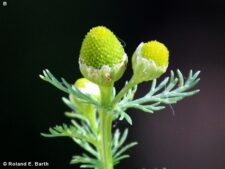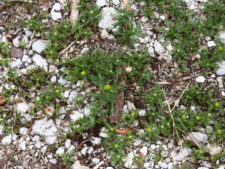
This weedy species smells like pineapple when crushed. It may grow up to a foot tall, but is usually much shorter. It prefers disturbed areas, particularly inhospitable sites with compacted soils such as roadsides and trail edges (C). The greenish-yellow cone-shaped flower heads are composed of disk florets only; there are no ray florets (B). The highly dissected fern-like leaves are somewhat succulent. As the yellowish disk flowers mature, they are replaced by brown seeds.
This weed had not been seen recently in Fontenelle Forest until after the floods of 2010/11. It was found growing on the Fontenelle Forest floodplain in May 2013 in the middle of Cottonwood Trail and along the side of Camp Gifford Road. The abundance is yet unknown, but it likely will spread. Flowering occurs from April to June.
Pineapple Weed is believed to be native to Asia. Based on specimens taken by Meriwether Lewis of the Lewis and Clark Expedition, it is likely also native to the Pacific Northwest. It has since spread over much of North America.
One of Pineapple Weed’s alternate common names is Wild Chamomile; a name likely prompted by its similarity to Chamomile (Matricaria chamomilla), a common ingredient of many of our herbal teas. Pineapple Weed has also been used to make an acceptable herbal tea. Although their floral scent is similar, Chamomile has a showier daisy-like flower with white ray florets.
The content of NatureSearch is provided by dedicated volunteer Naturalists of Fontenelle Forest who strive to provide the most accurate information available. Contributors of the images retain their copyrights. The point of contact for this page is: Roland Barth.

 Identification
Identification
